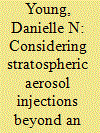|
|
|
Sort Order |
|
|
|
Items / Page
|
|
|
|
|
|
|
| Srl | Item |
| 1 |
ID:
190918


|
|
|
|
|
| Summary/Abstract |
Stratospheric Aerosol Injection (SAI), is often referred to as a ‘Plan B’ if mitigation strategies to reduce emissions fail and the need to rapidly reduce global temperatures becomes urgent. In theory, SAI would help buy more time to bring carbon and other emissions down while also cooling or keeping the planet below the threshold for dangerous warming, though it is not a solution to the problem of climate change in itself. What little attention it has received in International Relations (IR) is usually focused on the need for governance of the technology and assumes that development and use of the technology will be driven primarily by vulnerability to climate impacts. Through an analysis of common security assumptions and preemptive security framings the article shows that while current assessments of SAI focus on the technology’s environmental impact, broader political and security dynamics, particularly the desire to render climate change more intelligible as a security problem with a solution may have substantial influence on how the technology is used and by whom.
|
|
|
|
|
|
|
|
|
|
|
|
|
|
|
|
| 2 |
ID:
168380


|
|
|
|
|
| Summary/Abstract |
Given current emissions trends an increase in global temperatures in excess of 2°C is highly likely in the coming century. In this context, it seems increasingly probable that states may consider solar geoengineering as a stop-gap climate response. Solar geoengineering refers to measures that aim to alleviate some measure of global warming by intentionally increasing the amount of the sun’s energy that is reflected into space. Currently the two most discussed solar geoengineering techniques involve either marine cloud brightening or dispersing aerosols in the stratosphere. These techniques could be relatively inexpensive, are within the technological capacities (after a brief period of development) of technologically-advanced countries, and could have an almost immediate impact on temperatures. Yet, while solar geoengineering might potentially be utilised to manage some climate-linked security threats, it itself would create new security challenges. Consequently, this paper explores potential international security implications for Australia if a regional state, or group of states, initiates a solar geoengineering program. We conclude that since solar geoengineering is unlikely to become a first-order international issue, disputation over solar geoengineering will likely reflect, or act as a proxy for, wider patterns of state interaction. However, scenarios in which China and the United States take different positions, or in which there are divisions among regional powers, such as Indonesia, Malaysia, India and Singapore would pose the greatest threat to Australia’s national security.
|
|
|
|
|
|
|
|
|
|
|
|
|
|
|
|
| 3 |
ID:
164440


|
|
|
|
|
| Summary/Abstract |
What is a Classical Realist analysis of climate ethics and politics? Classical Realist ethical analysis differs from ideal normative theory in that it addresses state decision-makers rather than individuals, assumes highly imperfect compliance with the demands of justice, and is concerned with feasibility and transition rather than end-states. Classical Realists urge leaders to prioritise state security over private moral concerns, to assess rival policies against their likely consequences and to seek the ‘lesser evil’ among feasible choices. But how does Realism respond when the prudent pursuit of state security risks rendering much of the planet uninhabitable? In the 1950s, the development of the hydrogen bomb created just such a dilemma as status quo politics now carried a significant risk of thermonuclear omnicide. In response, Hans Morgenthau argued that states should manage systemic risk by working in concert to safeguard expanded, collective national interests. The Classical Realist mode of thought suggests an analogous response to systemic climate risks: states’ conceptions of national interest must expand to include cooperative system-preservation alongside traditional security concerns. Classical Realist arguments might then be mobilised to overcome resistance from vested interests and to support state-directed low carbon innovation, adaptation and mitigation agreements that prioritise ambition over distributional justice.
|
|
|
|
|
|
|
|
|
|
|
|
|
|
|
|
|
|
|
|
|